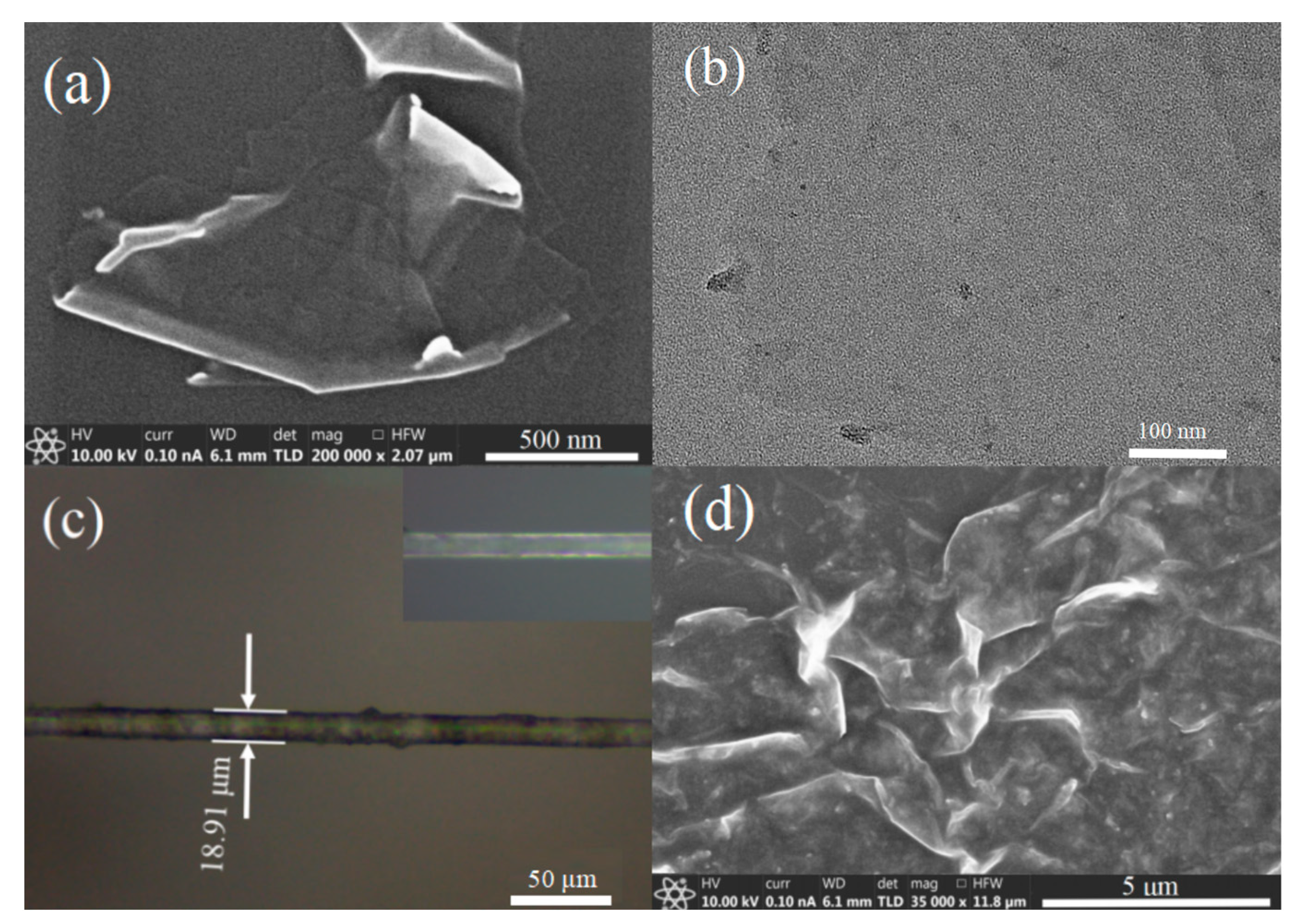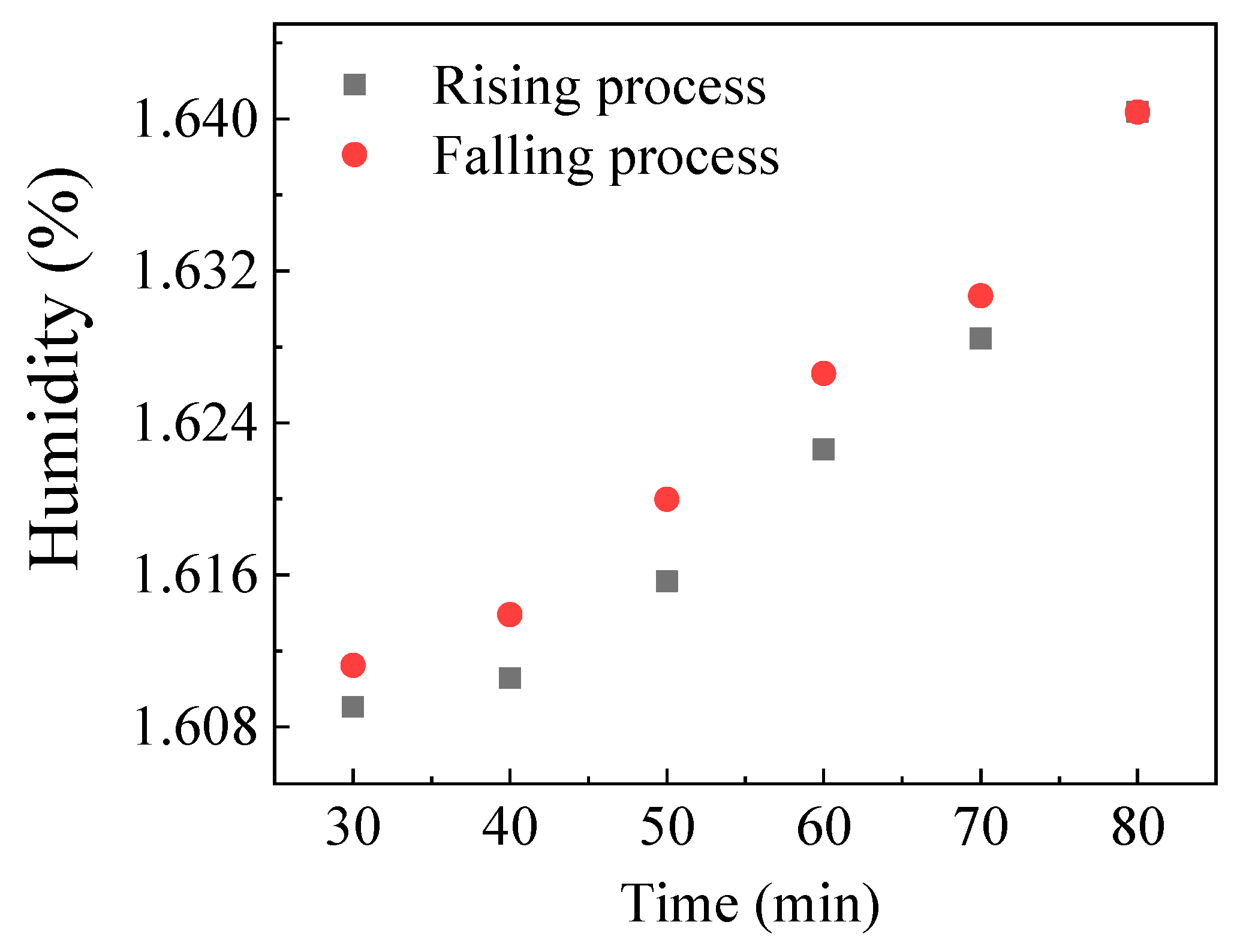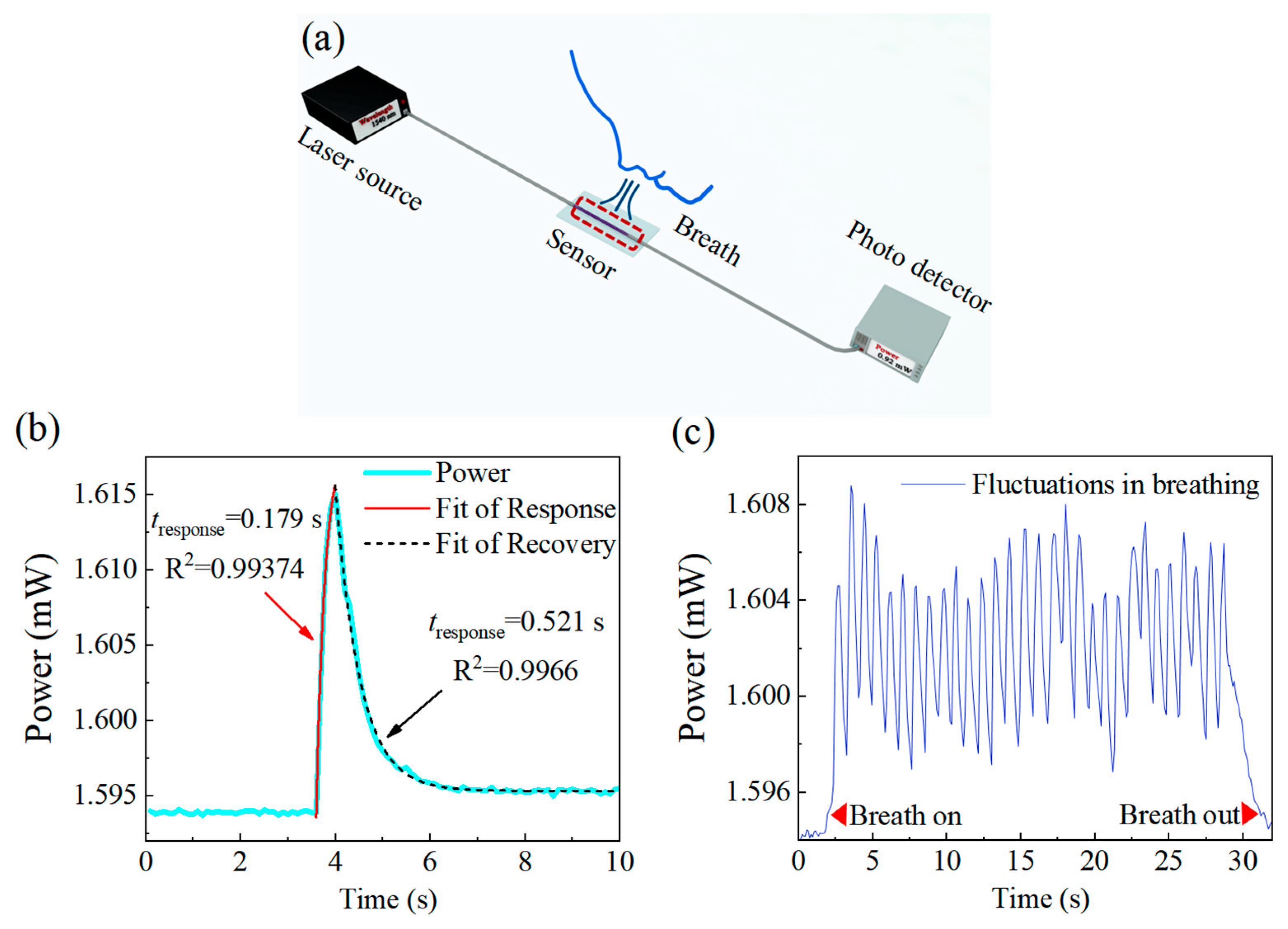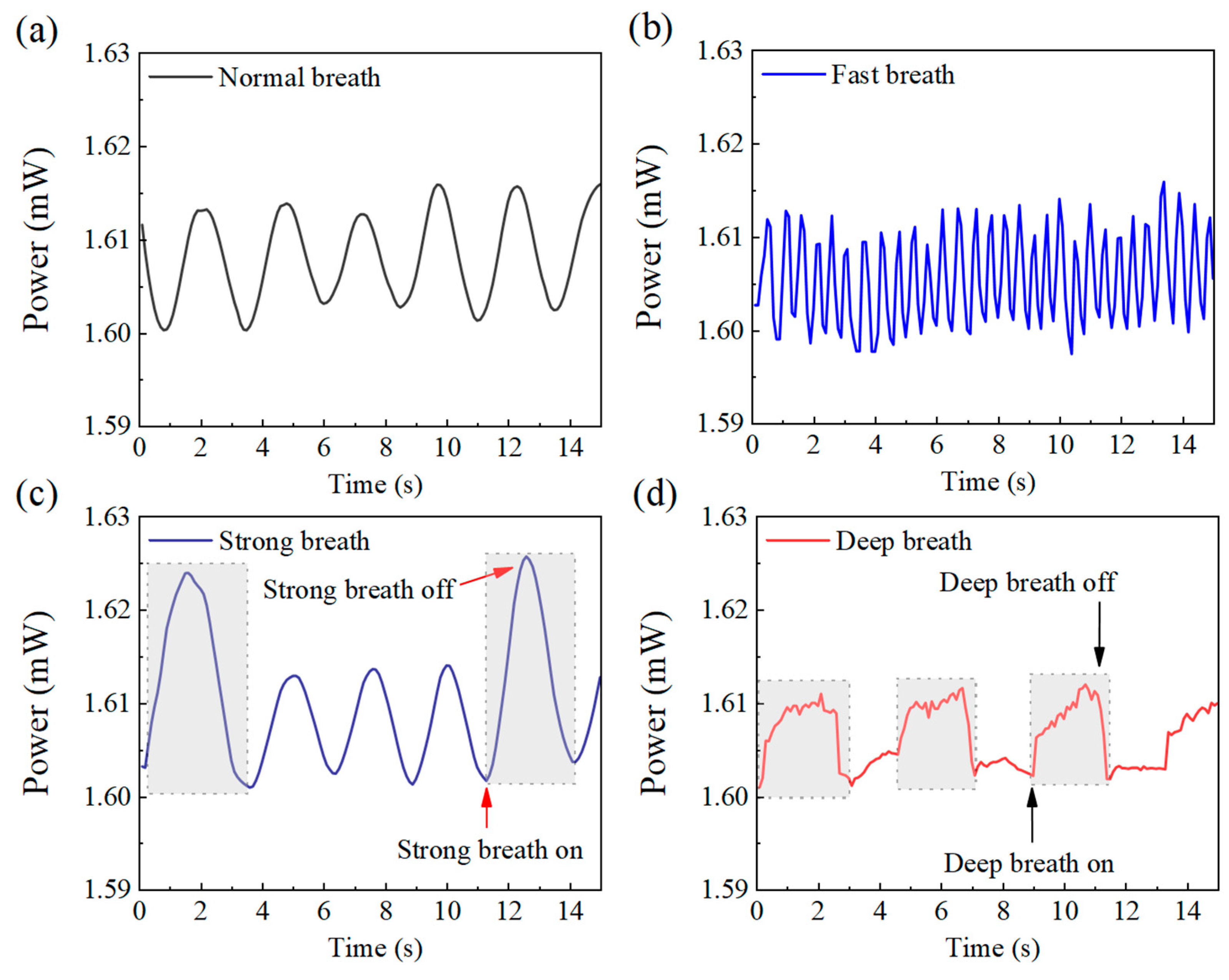MXene-Based Fiber-Optic Humidity Sensor for Fast Human Breath Monitoring
Abstract
1. Introduction
2. Experiments
3. Results and Discussion
4. Conclusions
Author Contributions
Funding
Institutional Review Board Statement
Informed Consent Statement
Data Availability Statement
Conflicts of Interest
References
- Duan, Z.; Jiang, Y.; Tai, H. Recent advances in humidity sensors for human body related humidity detection. J. Mater. Chem. C 2021, 9, 14963–14980. [Google Scholar] [CrossRef]
- Mihailov, S.J.; Ding, H.; Hnatovsky, C.; Walker, R.B.; Lu, P.; De Silva, M. Through-The-Coating Fabrication of Fiber Bragg Grating Relative Humidity Sensors Using Femtosecond Pulse Duration Infrared Lasers and a Phase Mask. Photonics 2023, 10, 625. [Google Scholar] [CrossRef]
- Guan, X.; Hou, Z.; Wu, K.; Zhao, H.; Liu, S.; Fei, T.; Zhang, T. Flexible humidity sensor based on modified cellulose paper. Sens. Actuators B Chem. 2021, 339, 129879. [Google Scholar] [CrossRef]
- Romero, F.J.; Rivadeneyra, A.; Salinas-Castillo, A.; Ohata, A.; Morales, D.P.; Becherer, M.; Rodriguez, N. Design, fabrication and characterization of capacitive humidity sensors based on emerging flexible technologies. Sens. Actuators B Chem. 2019, 287, 459–467. [Google Scholar] [CrossRef]
- Awais, M.; Khan, M.U.; Hassan, A.; Bae, J.; Chattha, T.E. Printable highly stable and superfast humidity sensor based on two dimensional molybdenum diselenide. Sci. Rep. 2020, 10, 5509. [Google Scholar] [CrossRef] [PubMed]
- Lee, S.P.; Park, K.-J. Humidity sensitive field effect transistors. Sens. Actuators B Chem. 1996, 35, 80–84. [Google Scholar] [CrossRef]
- Waheed, W.; Anwer, S.; Khan, M.U.; Sajjad, M.; Alazzam, A. 2D Ti3C2Tx-MXene nanosheets and graphene oxide based highly sensitive humidity sensor for wearable and flexible electronics. Chem. Eng. J. 2023, 480, 147981. [Google Scholar] [CrossRef]
- Wu, X.; Gao, F.; Jin, F.; Wang, D.; Wang, W.; Chen, Q.; Yang, H.; Gong, H.; Wang, Z.; Zhao, C.; et al. Optical fiber humidity sensor with C60-THAM as molecule receptors. Sens. Actuators B: Chem. 2022, 370, 132344. [Google Scholar] [CrossRef]
- Chiu, Y.-D.; Wu, C.-W.; Chiang, C.-C. Tilted fiber Bragg grating sensor with graphene oxide coating for humidity sensing. Sensors 2017, 17, 2129. [Google Scholar] [CrossRef]
- Wang, N.; Tian, W.; Zhang, H.; Yu, X.; Yin, X.; Du, Y.; Li, D. An easily fabricated high performance Fabry-Perot optical fiber humidity sensor filled with graphene quantum dots. Sensors 2021, 21, 806. [Google Scholar] [CrossRef]
- Presti, D.L.; Massaroni, C.; Schena, E. Optical fiber gratings for humidity measurements: A review. IEEE Sens. J. 2018, 18, 9065–9074. [Google Scholar] [CrossRef]
- Wang, W.; Sun, T.; Peng, J.; Dai, J.; Yang, M. Humidity sensor based on fiber Bragg grating coated with different pore-foaming agent doped polyimides. IEEE Photon-Technol. Lett. 2017, 29, 1963–1966. [Google Scholar] [CrossRef]
- Du, B.; Yang, D.; She, X.; Yuan, Y.; Mao, D.; Jiang, Y.; Lu, F. MoS2-based all-fiber humidity sensor for monitoring human breath with fast response and recovery. Sens. Actuators B Chem. 2017, 251, 180–184. [Google Scholar] [CrossRef]
- Lang, C.; Liu, Y.; Cao, K.; Li, Y.; Qu, S. Ultra-compact, fast-responsive and highly-sensitive humidity sensor based on a polymer micro-rod on the end-face of fiber core. Sens. Actuators B Chem. 2019, 290, 23–27. [Google Scholar] [CrossRef]
- Yi, Y.; Jiang, Y.; Zhao, H.; Brambilla, G.; Fan, Y.; Wang, P. High-performance ultrafast humidity sensor based on microknot resonator-assisted Mach–Zehnder for monitoring human breath. ACS Sens. 2020, 5, 3404–3410. [Google Scholar] [CrossRef] [PubMed]
- Li, D.; Lu, H.; Qiu, W.; Dong, J.; Guan, H.; Zhu, W.; Yu, J.; Luo, Y.; Zhang, J.; Chen, Z. Molybdenum disulfide nanosheets deposited on polished optical fiber for humidity sensing and human breath monitoring. Optics Express 2017, 25, 28407–28416. [Google Scholar] [CrossRef]
- Jiang, B.; Bi, Z.; Hao, Z.; Yuan, Q.; Feng, D.; Zhou, K.; Zhang, L.; Gan, X.; Zhao, J. Graphene oxide-deposited tilted fiber grating for ultrafast humidity sensing and human breath monitoring. Sens. Actuators B Chem. 2019, 293, 336–341. [Google Scholar] [CrossRef]
- Lou, J.; Wang, Y.; Tong, L. Microfiber optical sensors: A review. Sensors 2014, 14, 5823–5844. [Google Scholar] [CrossRef]
- Peng, Y.; Zhao, Y.; Chen, M.; Xia, F. Research advances in microfiber humidity sensors. Small 2018, 14, e1800524. [Google Scholar] [CrossRef]
- Yan, Z.; Wang, C.; Yu, R.; Hu, Z.; Xiao, L. Graphitic carbon nitride for enhancing humidity sensing of microfibers. J. Light. Technol. 2021, 39, 3896–3902. [Google Scholar] [CrossRef]
- Naguib, M.; Mochalin, V.N.; Barsoum, M.W.; Gogotsi, Y. Two-dimensional materials: 25th anniversary article: MXenes: A new family of two-dimensional materials. Adv. Mater. 2014, 26, 982. [Google Scholar] [CrossRef]
- Vahid Mohammadi, A.; Rosen, J.; Gogotsi, Y. The world of two-dimensional carbides and nitrides (MXenes). Science 2021, 372, 1581. [Google Scholar] [CrossRef] [PubMed]
- Wang, Y.; Xu, Y.; Hu, M.; Ling, H.; Zhu, X. MXenes: Focus on optical and electronic properties and corresponding applications. Nanophotonics 2020, 9, 1601–1620. [Google Scholar] [CrossRef]
- Jiang, X.; Liu, S.; Liang, W.; Luo, S.; He, Z.; Ge, Y.; Wang, H.; Cao, R.; Zhang, F.; Wen, Q.; et al. Broadband nonlinear photonics in few-layer MXene Ti3C2Tx (T = F, O, or OH). Laser Photonics Rev. 2018, 12, 1700229. [Google Scholar] [CrossRef]
- Hantanasirisakul, H.; Gogotsi, Y. Electronic and optical properties of 2D transition metal carbides and nitrides (MXenes). Adv. Mater. 2018, 30, 1804779. [Google Scholar] [CrossRef] [PubMed]
- Huang, Z.; Cui, X.; Li, S.; Wei, J.; Li, P.; Wang, Y.; Lee, C.-S. Two-dimensional MXene-based materials for photothermal therapy. Nanophotonics 2020, 9, 2233–2249. [Google Scholar] [CrossRef]
- Li, X.; Chong, Y.; Wang, J.; Xue, T.; Yan, J.; Feng, D.; Jiang, Y.; Zou, J.; Du, B.; Yang, D. A linear chirp fiber Bragg grating with tunable bandwidth enabled by MXene’s photothermal effect. Appl. Phys. Lett. 2023, 123, 163504. [Google Scholar] [CrossRef]
- Ho, D.H.; Choi, Y.Y.; Jo, S.B.; Myoung, J.; Cho, J.H. Sensing with MXenes: Progress and prospects. Adv. Mater. 2021, 33, 2005846. [Google Scholar] [CrossRef]
- Bi, M.; Miao, Y.; Li, W.; Yao, J. Niobium carbide MXene-optics fiber-sensor for high sensitivity humidity detection. Appl. Phys. Lett. 2022, 120, 021103. [Google Scholar] [CrossRef]
- Dillon, A.D.; Ghidiu, M.J.; Krick, A.L.; Griggs, J.; May, S.J.; Gogotsi, Y.; Barsoum, M.W.; Fafarman, A.T. Highly conductive optical quality solution-processed films of 2D titanium carbide. Adv. Funct. Mater. 2016, 26, 4162–4168. [Google Scholar] [CrossRef]
- Wu, L.; Yuan, X.; Tang, Y.; Wageh, S.; Al-Hartomy, O.A.; Al-Sehemi, A.G.; Yang, J.; Xiang, Y.; Zhang, H.; Qin, Y. MXene sensors based on optical and electrical sensing signals: From biological, chemical, and physical sensing to emerging intelligent and bionic devices. PhotoniX 2023, 4, 15. [Google Scholar] [CrossRef]
- Pei, Y.; Zhang, X.; Hui, Z.; Zhou, J.; Huang, X.; Sun, G.; Huang, W. Ti3C2Tx MXene for sensing applications: Recent progress, design principles, and future perspectives. ACS Nano 2021, 15, 3996–4017. [Google Scholar] [CrossRef] [PubMed]
- Lee, E.; Vahid Mohammadi, A.; Prorok, B.C.; Yoon, Y.S.; Beidaghi, M.; Kim, D.-J. Room temperature gas sensing of two-dimensional titanium carbide (MXene). ACS Appl. Mater. Interfaces 2017, 9, 37184–37190. [Google Scholar] [CrossRef]
- Celerier, S.; Hurand, S.; Garnero, C.; Morisset, S.; Benchakar, M.; Habrioux, A.; Chartier, P.; Mauchamp, V.; Findling, N.; Lanson, B.; et al. Hydration of Ti3C2Tx MXene: An interstratification process with major implications on physical properties. Chem. Mater. 2019, 31, 454–461. [Google Scholar] [CrossRef]
- Wu, J.; Lu, P.; Dai, J.; Zheng, C.; Zhang, T.; Yu, W.W.; Zhang, Y. High performance humidity sensing property of Ti3C2Tx MXene-derived Ti3C2Tx/K2Ti4O9 composites. Sens. Actuators B Chem. 2021, 326, 128969. [Google Scholar] [CrossRef]
- An, H.; Habib, T.; Shah, S.; Gao, H.; Patel, A.; Echols, L.; Zhao, X.; Radovic, M.; Green, M.J.; Lutkenhaus, J.L. Water sorption in MXene/polyelectrolyte multilayers for ultrafast humidity sensing. ACS Appl. Nano Mater. 2019, 2, 948–955. [Google Scholar] [CrossRef]
- Chen, J.; Qin, W.; Li, K.; Feng, L.; Chen, J.; Qiao, H.; Yang, M.; Tian, Z.; Li, X.; Gu, C.; et al. A high-sensitivity, fast-response and high-stability humidity sensor of curly flake Ti3C2Tx MXene prepared by electrolytic intercalation of NaOH solution. J. Mater. 2022, 10, 22278–22288. [Google Scholar] [CrossRef]
- Wang, L.; Tian, M.; Zhang, Y.; Sun, F.; Qi, X.; Liu, Y.; Qu, L. Helical core-sheath elastic yarn-based dual strain/humidity sensors with MXene sensing layer. J. Mater. Sci. 2020, 55, 6187–6194. [Google Scholar] [CrossRef]
- Kano, S.; Kim, K.; Fujii, M. Fast-response and flexible nanocrystal-based humidity sensor for monitoring human respiration and water evaporation on skin. ACS Sens. 2017, 2, 828–833. [Google Scholar] [CrossRef]
- Du, B.; Yang, D.; Ruan, Y.; Jia, P.; Ebendorff-Heidepriem, H. Compact plasmonic fiber tip for sensitive and fast humidity and human breath monitoring. Opt. Lett. 2020, 45, 985–988. [Google Scholar] [CrossRef] [PubMed]
- Yuan, W.; Yang, K.; Peng, H.; Li, F.; Yin, F. A flexible VOCs sensor based on a 3D Mxene framework with a high sensing performance. J. Mater. Chem. A 2018, 6, 18116–18124. [Google Scholar] [CrossRef]
- Koh, H.-J.; Kim, S.J.; Maleski, K.; Cho, S.-Y.; Kim, Y.-J.; Ahn, C.W.; Gogotsi, Y.; Jung, H.-T. Enhanced selectivity of MXene gas sensors through metal ion intercalation: In situ X-ray diffraction study. ACS Sens. 2019, 4, 1365–1372. [Google Scholar] [CrossRef] [PubMed]
- Wu, M.; He, M.; Hu, Q.; Wu, Q.; Sun, G.; Xie, L.; Zhang, Z.; Zhu, Z.; Zhou, A. Ti3C2 MXene-based sensors with high selectivity for NH3 detection at room temperature. ACS Sens. 2019, 4, 2763–2770. [Google Scholar] [CrossRef] [PubMed]
- Janica, I.; Montes-García, V.; Urban, F.; Hashemi, P.; Nia, A.S.; Feng, X.; Samorì, P.; Ciesielski, A. Covalently Functionalized MXenes for Highly Sensitive Humidity Sensors. Small Methods 2023, 7, e2201651. [Google Scholar] [CrossRef]
- Luo, Y.; Chen, C.; Xia, K.; Peng, S.; Guan, H.; Tang, J.; Lu, H.; Yu, J.; Zhang, J.; Xiao, Y.; et al. Tungsten disulfide (WS2) based all-fiber-optic humidity sensor. Opt. Express 2016, 24, 8956–8966. [Google Scholar] [CrossRef]
- Gao, R.; Lu, D.; Cheng, J.; Jiang, Y.; Jiang, L.; Qi, Z. Humidity sensor based on power leakage at resonance wavelengths of a hollow core fiber coated with reduced graphene oxide. Sens. Actuators B Chem. 2016, 222, 618–624. [Google Scholar] [CrossRef]






| Structure | Material | Response Time/s | Recovery Time/s | Reference |
|---|---|---|---|---|
| Microfiber | g-CN | 0.43 | 0.87 | [20] |
| Microfiber interferometer | Nb2CTX | 1.76 | 5.71 | [29] |
| Side-polished fiber | WS2 | 1 | 5 | [45] |
| Hollow-core fiber | RGO | 5.2 | 8.1 | [46] |
| ESMF | Ti3C2Tx | 0.176 | 0.521 | This work |
Disclaimer/Publisher’s Note: The statements, opinions and data contained in all publications are solely those of the individual author(s) and contributor(s) and not of MDPI and/or the editor(s). MDPI and/or the editor(s) disclaim responsibility for any injury to people or property resulting from any ideas, methods, instructions or products referred to in the content. |
© 2024 by the authors. Licensee MDPI, Basel, Switzerland. This article is an open access article distributed under the terms and conditions of the Creative Commons Attribution (CC BY) license (https://creativecommons.org/licenses/by/4.0/).
Share and Cite
Li, X.; Sun, B.; Xue, T.; Pan, K.; Su, Y.; Jiang, Y.; Du, B.; Yang, D. MXene-Based Fiber-Optic Humidity Sensor for Fast Human Breath Monitoring. Photonics 2024, 11, 79. https://doi.org/10.3390/photonics11010079
Li X, Sun B, Xue T, Pan K, Su Y, Jiang Y, Du B, Yang D. MXene-Based Fiber-Optic Humidity Sensor for Fast Human Breath Monitoring. Photonics. 2024; 11(1):79. https://doi.org/10.3390/photonics11010079
Chicago/Turabian StyleLi, Xiaokang, Binchuan Sun, Ting Xue, Kangwei Pan, Yuhui Su, Yajun Jiang, Bobo Du, and Dexing Yang. 2024. "MXene-Based Fiber-Optic Humidity Sensor for Fast Human Breath Monitoring" Photonics 11, no. 1: 79. https://doi.org/10.3390/photonics11010079
APA StyleLi, X., Sun, B., Xue, T., Pan, K., Su, Y., Jiang, Y., Du, B., & Yang, D. (2024). MXene-Based Fiber-Optic Humidity Sensor for Fast Human Breath Monitoring. Photonics, 11(1), 79. https://doi.org/10.3390/photonics11010079






